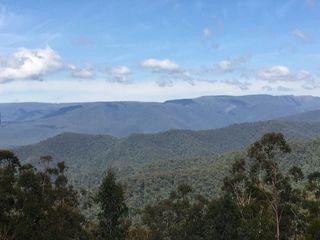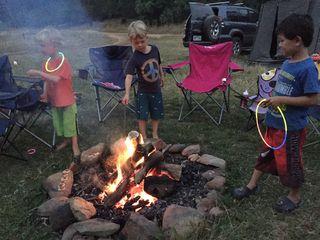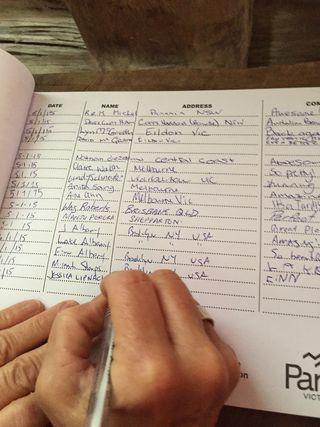
Conglomerate Creek, Vic., Australia, January 3, 2015—By some measure, it's my mother's 104th birthday but in my now it's only January 2 in Brooklyn where she was born, a universe away in terms of terrain and technology, me sitting here in the Victorian High Country in the south of Australia a century later with an iPad, her family on the corner of Myrtle and Clinton with a Victrola.
Outstralia. The Outback for sure. My camping seat is just a few grassy feet from the river bank. Lake and Finn are playing with Magna-tiles in the camper trailer and Miranda and Jay are setting up for a two-night stay, as are the other seven groups comprising three couples, two fathers and sons, and three families including us. We're on a 4WD (four wheel
drive, dummies) tour sponsored by Great Divide Tours, the company through which my kids arranged to acquire their carefully kitted out Land Cruiser and camper trailer, both customized for their adventure of which these few days involve just one interesting side-trip in their probably year-long journey.
You do not see Australia this way from a car, going to the traditional attractions. You can't get here from there. Off road. Off line. Out Back in the bush.
We're camping again, five of us sleeping in the camper trailer, a roomy set-up with canvas sides that folds up into a steel box for travel but which also does a back bend to produce a queen bed with an equivalent amount of storage space underneath, two sets of drawers, and a hard-floor platform big enough for three people to sleep.
We joined the tour almost on a whim and certainly without a great deal of preparation. We thought about it for a day, then woke up the next morning, packed up, shopped for 75 meals (5 people times 5 days times 3 meals per day), and rushed off to “Talbotville”-- which sounds like it might be a town, right?, no, wrong—to meet the tour that had started two days earlier. Our aim was to be there with enough daylight to set up camp, meet the others, have dinner, and hit the sack.
And so we drove to the original campsite following the GPS (technically "Donna") to Mt. Hotham in the Australian Alps then peeled off the paved road for some 50 kilometers of various versions of dirt—rutted track, gravel, the reddest soil you’ve ever seen—itself a windy, barely one-lane wide curlicue up into Great Alpine National Forest. And by up, I mean a 30-degree pitch, a 40-degree pitch, a 50-degree pitch, and I’m not exaggerating.

At a certain elevation the trees turned white, without leaves, without branches, with harsh black scars on their barkless trunks. How odd, how odd, not like any vegetation I could identify until one of the boys said, “There was a forest fire.” Of course. Everything is so different that I'd forgotten to throw common sense into my backpack. Fire may be a natural part of the forest's cycle but it leaves a very bleak footprint.
On we drove, to a sign for Grant, suggesting that there might be a settlement there (no), another for Grant's Cemetery (ok, something is settled there but it’s a bit hard to converse), until we started our descent, down to the Crooked River valley, so named for its meandering spine, and to Talbotville. Originally a mining town of 10,000 or so, today not a trace remains. Once the gold was scooped out, the inhabitants packed up their belongings—including their houses and shops and churches and stables and storehouses—and moved their infrastructure on to the next site of eventual abandonment.
When we arrived, we found fifty or so tents and camper trailers scattered about the ghost town, one “pump out” toilet (don’t ask), and three camper trailers that matched the description we’d been given of the group we were to meet. But no people appeared to be with the camper trailers, nor were their cars anywhere to be seen.
We wandered over to a nearby family—George and Nicole from Melbourne, and their two children Callum (6) and Michaela (3), welcome specimens to our two five-year-olds—and asked if they knew where are fellow tour-ers might be. They’d left that morning, Nicole said, in a convoy across the river and up the hill. It was getting later and later and so we decided to make dinner. Out came the camp kitchen, supplies emerged from the refrigerators and drawers, and before long we were eating and sharing George and Nicole’s camp fire with Finny playing chef to introduce the Aussies to S’mores.

.
By now it was 9 PM and our group still had not appeared. Miranda called Vic Widman, Mr. Great Divide Tours, and asked if he might know anything. His tracking system had detected that they had been on the side of Pinnacle Point mountain for three hours or so earlier in the day and were now making their way back, implying that there could have been a breakdown with one of the cars or they found something interesting or…
My mind traveled over much territory landing on the possibility that the Outback might be where aliens pluck their next inductees. After all, it’s so sparsely populated that who would ever know—except Vic Widman and us and George and Nicole and eventually everyone—but there would be no eyewitnesses. Yikes. My first night in the Outback and flying saucers have abducted the people we’re supposed to be four-wheel-driving with for the next five days. Time turned to the next hour and just then, out of the darkness, a line of light appeared up the hill, one car with lights ablazing, then another and another and another, unmistakably our group.
“I’m free! I’m free!” yelled Michelle, leaping from her 4WD. She turned out to be the lynchpin of the group, taking pictures, befriending everyone, offering helpful advice, and telling stories that should be on The Moth.
***
Another day: It is hot hot hot, so hot that Miranda and I just waded into the muddy (squish, squich) river to cool off, so hot that we just sat down on the stones beyond the mud. It worked. We drove again all day—up and down, over the innocuously named “conservation mounds,” moguls, really, that break the pitch of roads that you would not in your right mind hike up, never mind drive. Steep is one word vaguely suggestive of the impression these climbs leave; straight up might be more accurate. If you were to walk it, well, would you? You'd—or at least I—would need cramp-ons, a pitchfork for a walking stick, preferably accompanied by a mountain goat who would know where to put a foot or four.
Every turn of the wheel in our creeping caravan—which could mean there were some thirty or more tires in front of us depending on our slot in line—kicked up the dust, so thick at times that rescue inhalers were necessary, so opaque that we couldn’t see twenty feet in front of us.
Our phalanx of heavy duty robots—for these vehicles are different from normal cars (they have twelve gears, for example, and some have hydraulics that raise and lower the chassis to accommodate the furrows and grooves)—inched along ten-foot-wide black diamond trails, sometimes even narrower couloirs, sometimes more, up up up, sheer snaking slopes, then down down down at 60 degree drops, crossing water after water—22 crossings of The Crooked River yesterday—and on again, now coated in red dust, crackling UHF messages from the front of the pack to the end: “There’s an oncoming vehicle, mate, so pull over;” “it’s a bit ordinary here so walk it down;” “There’s a stump in the middle of the track so it’s a bit tight.”
It sounded so innocuous until we were walking it down, the car having been shifted into 4WD’s “low 1,” which meant the engine did the braking not the foot. After twenty or thirty of these plus a string of hairpin turns that Jay executed perfectly, they began to feel like the only places on Earth as Route 93, EZ Pass, and Rest Areas Ahead receded to their historical niches like my grandparents’ Victrola.
When a vehicle did come in our direction, we had to swing off to the edge of a ravine or nestle under a chalky cliff. It always seemed as if the oncoming cars were driving very fast as we crawl along rarely exceeding 20 or 25kmh, sometimes much slower than that.
It was day after day of bumpy roller coaster rides without the whoop and sans the stomach drop. Much of the time the forest resembled our beloved Bear Island, thick woods with dirt paths--only these were gums and eucalyptus and tea trees not maples and oaks and birches—and then it didn’t look like Earth at all.
So long as we stayed in the euphemistic comfort of our air conditioned car—which came to an end on the last day of the trip due to the need to conserve fuel—everyone was down to their last few kilometers as we hadn’t been able to fuel up since our second day at Dargo, the one live town where we stopped—a pub! a gas station! Bitumen roads!—we could tolerate the heat but once we left the car, a requirement of camping for the night, the heat sweltered us in blankets, electric spreads in which the thermostat continued to be turned up.
That was this evening when we made camp at Conglomerate Creek, internal temperatures rising for everyone, bull ants biting, adults and kids arguing, one couple exploding into a fight heard round the camp. Even the sudden wind doesn't cool these tempers until night fell and the sun moved on to the moods of other families, other campsites.


